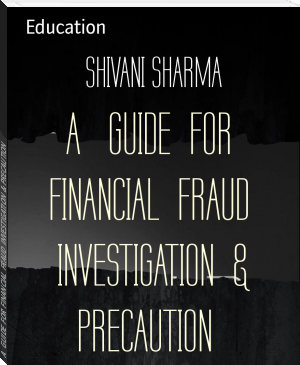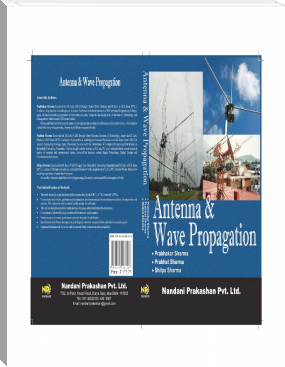A GUIDE FOR FINANCIAL FRAUD INVESTIGATION & PRECAUTION, SHIVANI SHARMA [read my book txt] 📗

- Author: SHIVANI SHARMA
Book online «A GUIDE FOR FINANCIAL FRAUD INVESTIGATION & PRECAUTION, SHIVANI SHARMA [read my book txt] 📗». Author SHIVANI SHARMA
To force a defaulter into paying, the lender might threaten legal action. This was a bluff, since the loan was illegal. The lender preyed on the borrower's ignorance of the law. Alternatively, the lender resorted to public shaming, exploiting the social stigma of being in debt to a loan shark. They were able to complain to the defaulter's employer, because many employers would fire employees who were mired in debt, because of the risk of them stealing from the employer to repay debts. They were able to send agents to stand outside the defaulter's home, loudly denouncing him, perhaps vandalizing his home with graffiti or notices. Whether out of gullibility or embarrassment, the borrower usually succumbed and paid.
Many customers were employees of large firms, such as railways or public works. Larger organizations were more likely to fire employees for being in debt, as their rules were more impersonal, which made blackmail easier. It was easier for lenders to learn which large organizations did this as opposed to collecting information on the multitude of smaller firms. Larger firms had more job security and the greater possibility of promotion, so employees sacrificed more to ensure they were not fired. The loan shark could also bribe a large firm's paymaster to provide information on its many employees. Regular salaries and paydays made negotiating repayment plans simpler.[9]
The size of the loan and the repayment plan were often tailored to suit the borrower's means. The smaller the loan, the higher the interest rate was, as the costs of tracking and pursuing a defaulter (the overhead) were the same whatever the size of the loan. The attitudes of lenders to defaulters also varied: some were lenient and reasonable, readily granting extensions and slow to harass, while others unscrupulously tried to milk all they could from the borrower (e.g. imposing late fees).
Because salary lending was a disreputable trade, the owners of these firms often hid from public view, hiring managers to run their offices indirectly. To further avoid attracting attention, when expanding his trade to other cities, an owner would often found new firms with different names rather than expanding his existing firm into a very noticeable leviathan.
The penalties for being an illegal lender were mild. Illegal lending was a misdemeanor, and the penalty was forfeiture of the interest and perhaps the principal as well. But these were only ever imposed if the borrower sued, which he typically could not afford to do.[10]
Opposition to salary lenders was spearheaded by social elites, such as businessmen and charity organizations. Businessmen were encouraged not to fire employees who were indebted to loan sharks, as they unwittingly supported the industry by providing lenders with a means of blackmailing their customers ("pay up or we'll tell your boss and you'll be fired"). Charities provided legal support to troubled borrowers. This fight culminated in the drafting of the Uniform Small Loan Law, which brought into existence a new class of licensed lender. The law was enacted, first in several states in 1917, and was adopted by all but a handful of states by the middle of the 20th century.[11][page needed] The model statute mandated consumer protections and capped the interest rate on loans of $300 or less at 3.5% a month (42% a year), a profitable level for small loans. Lenders had to give the customer copies of all signed documents. Additional charges such as late fees were banned. The lender could no longer receive power of attorney or confession of judgment over a customer. These licensing laws made it impossible for usurious lenders to pass themselves off as legal. Small loans also started becoming more socially acceptable, and banks and other larger institutions started offering them as well.
20th-century gangsters[edit]
In the 1920s and 1930s, American prosecutors began to notice the emergence of a new breed of illegal lender that used violence to enforce debts. The new small lender laws had made it almost impossible to intimidate customers with a veneer of legality, and many customers were less vulnerable to shaming because they were either self-employed or already disreputable. Thus, violence was an important tool, though not their only one. These loan sharks operated more informally than salary lenders, which meant more discretion for the lender and less paperwork and bureaucracy for the customer. They were also willing to serve high-risk borrowers that legal lenders wouldn't touch.
Threats of violence were rarely followed through, however. One possible reason is that injuring a borrower could have meant he couldn't work and thus could never pay off his debt. Many regular borrowers realized the threats were mostly bluffs and that they could get away with delinquent payments. A more certain consequence was that the delinquent borrower would be cut off from future loans, which was serious for those who regularly relied on loan sharks.[12]
One important market for violent loan sharks was illegal gambling operators, who couldn't expose themselves to the law to collect debts legally. They cooperated with loan sharks to supply credit and collect payments from their punters. Thieves and other criminals, whose fortunes were frequently in flux, were also served, and these connections also allowed the loan sharks to operate as fences.[13] Another type of high-risk customer was the small businessman in dire financial straits who couldn't qualify for a legal loan.
Violent loansharking was typically run by criminal syndicates, such as the Mafia. Many of these were former bootleggers who needed a new line of work after the end of Prohibition. Towards the 1960s, loan sharks grew ever more coordinated, and could pool information on borrowers to better size up risks and ensure a borrower did not try to pay off one loan by borrowing from another loan shark. The fearsome reputation of the Mafia or similar large gang made the loan shark's threat of violence more credible.
Mafia links[edit]Origins in "salary buying", 1920-criminalization[edit]
Although the reform law was intended to starve the loan sharks into extinction, this species of predatory lender thrived and evolved. After high-rate salary lending was outlawed, some bootleg vendors recast the product as "salary buying". They claimed they were not making loans but were purchasing future wages at a discount. This form of loansharking proliferated through the 1920s and into the 1930s until a new draft of the Uniform Small Loan Law closed the loophole through which the salary buyers had slipped.[14] Salary-buying loan sharks continued to operate in some southern states after World War II because the usury rate was set so low that licensed personal finance companies could not do business there.[15]
Post-criminalization[edit]
Organized crime began to enter the cash advance business in the 1930s, after high-rate lending was criminalized by the Uniform Small Loan Law. The first reports of mob loansharking surfaced in New York City in 1935, and for 15 years, underworld money lending was apparently restricted to that city.[16] There is no record of syndicate "juice" operations in Chicago, for instance, until the 1950s.
In the beginning, underworld loansharking was a small loan business, catering to the same populations served by the salary lenders and buyers. Those who turned to the bootleg lenders could not get credit at the licensed companies because their incomes were too low or they were deemed poor risks. The firms operating within the usury cap turned away roughly half of all applicants and tended to make larger loans to married men with steady jobs and decent incomes.
Those who could not get a legal loan at 36% or 42% a year could secure a cash advance from a mobster at the going rate of 10% or 20% a week for small loans. Since the mob loans were not usually secured with legal instruments, debtors pledged their bodies as collateral.[17]
In its early phase, a large fraction of mob loansharking consisted of payday lending. Many of the customers were office clerks and factory hands. The loan fund for these operations came from the proceeds of the numbers racket and was distributed by the top bosses to the lower echelon loan sharks at the rate of 1% or 2% a week. The 1952 B-flick Loan Shark, starring George Raft, offers a glimpse of mob payday lending. The waterfront in Brooklyn was another site of extensive underworld payday advance operations around mid-century.
1960s heyday–present[edit]
Over time, mob loan sharks moved away from such labor intensive rackets. By the 1960s, the preferred clientele was small and medium-sized businesses. Business customers had the advantage of possessing assets that could be seized in case of default, or used to engage in fraud or to launder money. Gamblers were another lucrative market, as were other criminals who needed financing for their operations. By the 1970s, mob salary lending operations seemed to have withered away in the United States.[18]
At its height in the 1960s, underworld loansharking was estimated to be the second most lucrative franchise of organized crime in the United States after illegal gambling. Newspapers in the 1960s were filled with sensational stories of debtors beaten, harassed, and sometimes murdered by mob loan sharks. Yet careful studies of the business have raised doubts about the frequency with which violence was employed in practice. Relations between creditor and debtor could be amicable, even when the "vig" or "juice" was exorbitant, because each needed the other. FBI agents in one city interviewed 115 customers of a mob loan business but turned up only one debtor who had been threatened. None had been beaten.[19]
Non-mafia sharks[edit]
Organized crime has never had a monopoly on black market lending. Plenty of vest-pocket lenders operated outside the jurisdiction of organized crime, charging usurious rates of interest for cash advances. These informal networks of credit rarely came to the attention of the authorities but flourished in populations not served by licensed lenders. Even today, after the rise of corporate payday lending in the United States, unlicensed loan sharks continue to operate in immigrant enclaves and low-income neighborhoods. They lend money to people who work in the informal sector or who are deemed to be too risky even by the check-cashing creditors. Some beat delinquents while others seize assets instead. Their rates run from 10% to 20% a week, just like the mob loan sharks of days gone by.[20]
UK loan sharks[edit]Main article: Payday loans in the United Kingdom
The research by the government and





Comments (0)